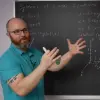

NARROW DISPLAY WARNING
You are most likely using a tablet or mobile device in portrait orientation. This website is best viewed using a typical computer screen with the browser window maximized.
Viewing this website in portrait orientation can cause problems with equations being longer than the screen width (you can scroll to the right), images being poorly sized, and the font size of maths text being much smaller than regular text. If your only option is a tablet or mobile device, your viewing experience will be better if you view this website in landscape orientation. You might need to refresh the page to fix any problems after rotating.
Given an IVP with a step size
\begin{equation} y' = f(x,y) \qquad y(x_{0}) = y_{0} \qquad \text{step size } \Delta x \end{equation}The next $x_{n+1} = x_{n} + \Delta x$ and the next $y_{n+1} = y_{n} + \Delta x f(x_{n},y_{n})$ and you iterate.
\begin{align} y_{new} &= y_{old} + (\text{change in $x$}) \frac{\text{change in $y$}}{\text{change in $x$}} \\ &= y_{old} + (\text{change in $y$}) \end{align}Apply Euler's method to the ODE.
\begin{equation} \frac{\text{d}y}{\text{d}t} = \frac{1}{2}y \qquad y(0) = 1 \qquad \Delta t = 1 \end{equation}Check your work using WolframAlpha.
Apply Euler's method to the ODE.
\begin{equation} \frac{\text{d}y}{\text{d}x} = -xy \qquad y(0) = 1 \qquad \Delta x = 0.2 \end{equation}Check your work using WolframAlpha.
Apply Euler's method to the ODE.
\begin{equation} \frac{\text{d}y}{\text{d}t} = y(3-y) \qquad y(2) = 1 \qquad \Delta t = 0.1 \end{equation}Check your work using WolframAlpha.